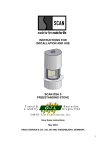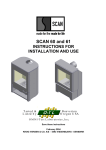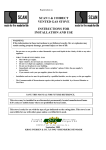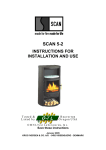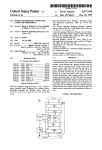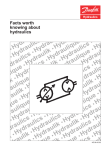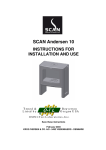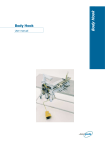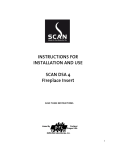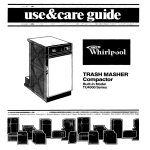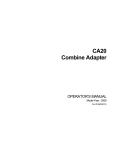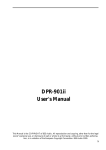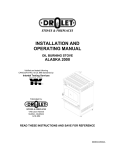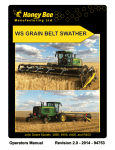Download INSTRUCTIONS FOR INSTALLATION AND USE SCAN DSA 4
Transcript
INSTRUCTIONS FOR INSTALLATION AND USE SCAN DSA 4 T es te d & L ist ed b y B ea v e r to n O r e g o n U SA O M N I-T e s t L a bo r a t o r ie s , In c. Save these instructions January 2004 Krog Iversen & CO. A/S, DK- 5492 Vissenbjerg Denmark Page 1 CONTENTS 1. IMPORTANT SAFETY NOTICE ..........................................................................................................................3 1.1 Prevent Creosote Fires:......................................................................................................................................3 1.2 Prevent Over Firing: ..........................................................................................................................................3 2. CAUTIONS.............................................................................................................................................................4 3. INTRODUCTION / INSTRUCTIONS FOR USE.................................................................................................5 3.1 About the SCAN DSA 4 fireplace.....................................................................................................................5 3.2 Baffle Cassette:..................................................................................................................................................5 3.3 Glass: .................................................................................................................................................................5 3.4 Smoke Detectors: ...............................................................................................................................................5 3.5 Room Ventilation: .............................................................................................................................................6 3.6 Firebricks and Skamol liners: ............................................................................................................................6 3.7 Ceramic gasket: .................................................................................................................................................6 3.8 Pre Installation Check List: ...............................................................................................................................6 4. INSTALLATION (Qualified technicians only) .....................................................................................................7 4.1 Fireplace size requirements ...............................................................................................................................7 4.2 Fireplace placement requirements .....................................................................................................................7 4.3 Hearth and floor protection requirements:.........................................................................................................8 4.3.1 Minimum Clearances:.................................................................................................................................8 4.4 Masonry Fireplace Requirements ......................................................................................................................9 4.5 Drafting Performance ........................................................................................................................................9 4.6 Fireplace with direct connection (Masonry fireplace).......................................................................................9 4.7 Surround Panel Installation (see part numbers below) ....................................................................................11 4.8 Combustion Air Supply:..................................................................................................................................11 4.9 Draft Requirements: ........................................................................................................................................12 4.10 Chemney Installation:....................................................................................................................................12 5. OPERATION ........................................................................................................................................................13 5.1 Fueling the fireplace: .......................................................................................................................................13 5.2 Starting a Fire: .................................................................................................................................................13 5.3 Refueling: ........................................................................................................................................................14 6. MAINTENANCE..................................................................................................................................................15 6.1 Ash Disposal and Removal: ............................................................................................................................15 6.2 Cleaning of fireplace: ......................................................................................................................................15 6.3 Removing Baffle Cassette for Cleaning: .........................................................................................................15 6.4 Creosote Formation and the Need for Removal: .............................................................................................16 6.5 Door Glass:......................................................................................................................................................16 6.5.1 Replacing Broken Door Glass: .................................................................................................................16 6.6 Replacement part list: ......................................................................................................................................17 6.7 Safety label: .....................................................................................................................................................17 7. WARRANTY PROVISIONS FOR SCAN WOOD BURNING PRODUCTS.....................................................18 8. TROUBLESHOOTING ........................................................................................................................................19 Page 2 Congratulations on your new SCAN DSA wood burning fireplace. We are confident that you will enjoy your new SCAN DSA fireplace, especially if you follow the instructions and advice given below. SCAN DSA fireplaces have a number plate. In case of complaints we request that you have the registration number. In the SCAN DSA fireplace you will find a service box containing the following items: 1 stove mitten 1 handle to operate the door 1 set of fittings for the flue collar 1 set of screws and hexagon spanners 1 bag of fire starters for the first lightning The SCAN DSA fireplaces have been tested by OMNI-Test Laboratories, Inc. of Beaverton, Oregon, and are listed by OMNI to UL 1482, ULC S628 and EPA certified. Please: read the entire manual before installing or operation your new fireplace. 1. IMPORTANT SAFETY NOTICE The SCAN DSA wood-burning fireplace is a closed fireplace. Protection against a fire hazard is of primary importance when installing a wood-burning fireplace. If utilizing an older chimney, it must be inspected for adequate serviceability. Refer to the heading: Chimney Installation (page 12). Minimum listed clearances to combustible surfaces and materials must be maintained, including; furniture, drapers, clothing, wood, papers, etc. 1.1 Prevent Creosote Fires: Both the chimney and chimney connector should be inspected for creosote deposits at least twice monthly during the heating season. Remove all buildups as necessary. This fireplace is approved for burning dry seasoned natural wood only. Using green or inadequately seasoned wood can greatly increase creosote buildup. 1.2 Prevent Over Firing: Do not over-fire! Over-firing the fireplace can cause a house fire. If the fireplace glows, you are over-firing. Damage caused from over firing is not covered by the manufactures limited warranty. Page 3 2. CAUTIONS IF THIS FIREPLACE IS NOT PROPERLY INSTALLED, A HOUSE FIRE MAY RESLUT. FOR YOUR SAFETY FOLLOW THESE INSTALLATION INSTRUCTIONS. CONTACT YOUR LOCAL BUILDING DEPARTMENT ABOUT RESTRICTIONS AND INSTALLATIONS INSPECTION IN YOUR AREA. KEEP START DEVICE CLOSED DURING FIRING OF THIS FIREPLACE, START DEVICE MAY BE OPENED FOR A MAXIMUM OF 5 MINUTES DURING FIRE STARTUP. NEVER USE GASOLINE, GASOLINE-TYPE LANTERN FUEL, KEROSENE, CHARCOAL LIGHTER FLUID, OR SIMILAR LIQUIDS TO START OR “FRESHEN UP” A FIRE IN THIS FIREPLACE KEEP ALL SUCH LIQUIDS WELL AWAY FROM THE FIREPLACE WHILE IT IS IN USE. DO NOT BURN GARBAGE OR FLAMMABLE FLUIDS SUCH AS GASOLINE, NAPHTHA OR ENGINE OIL. THIS FIREPLACE IS HOT WHILE IN OPERATION, DO NOT TOUCH, AND KEEP CHILDREN AWAY. CONTACT MAY CAUSE SKIN BURNS. USE GLOVES WHEN STOKING THE FIRE. DO NOT CONNECT THIS FIREPLACE TO A CHIMNEY FLUE CONNECTED TO ANOTHER FIREPLACE, STOVE OR APPLIANCE. DO NOT CONNECT TO ANY AIR DISTRIBUTION DUCT OR SYSTEM. DO NOT INSTALL IN A MOBILE HOME. BE SURE TO ALLOW AN ADEQUATE SOURCE OF FRESH AIR INTO THE ROOM WHERE THE FIREPLACE IS OPERATING (SEE ROOM VENTILATION PAGE 6 AND COMBUSTION AIR SUPPLY PAGE 12). DO NOT OPERATE THE FIREPLACE WITHOUT THE FIREBOX BAFFLE CASSETTE PROPERLY INSTALLED. BUILD FIRES DIRECTLY UPON THE HEARTH INSIDE THE FIREPLACE. DO NOT USE GRATES, IRONS OR ANY OTHER METHOD TO ELEVATE THE FIRE. THE SCAN DSA 4 FIREPLACE IS ONLY FOR FIREPLACE INSTALLATION. Page 4 3. INTRODUCTION / INSTRUCTIONS FOR USE 3.1 About the SCAN DSA 4 fireplace SCAN DSA 4: CAUTION: Do not operate the fireplace with the start device open or ajar, as this will produce extreme temperatures within the fireplace (over-firing), which could result in a house fire. Damage caused by over firing is not covered by the manufacturers limited warranty 3.2 Baffle Cassette: The SCAN DSA 4 has a baffle cassette assembly that must be installed in the upper firebox. When in the proper position, the lower plate should lay on top of the air manifold and against the rear wall of the firebox. See the maintenance section of this manual for additional information on removing baffle cassette for cleaning and for drawings of the firebox inclusive of baffle cassette of SCAN DSA fireplace (see page 16). A ceramic baffle cassette is delivered with all SCAN DSA fireplaces. When mounting a baffle cassette it must be done according to the description in section 6: Removing baffle cassette for cleaning. Make sure that it is placed symmetrically in the stove, i.e. with even amounts of free air space on each side. We recommend that you treat the ceramic baffle cassette (Skamol) with caution because it is a delicate material (not covered by the limited warranty). It is extremely heat resistant. 3.3 Glass: The glass is a heat resistance ceramic glass that can withstand continuous temperatures up to 1390°F (754°C). This temperature is well beyond the temperatures in which you operate your insert. This fireplace is designed to provide a flow of air over the inside of the glass. This air combined with high temperatures helps keep it optimally clean when the combustion air intake is fully opened. When operating the insert on low for extended periods of time, the glass may become dirty. A short, hot fire will help clean off much of the normal buildup (see section 8: Troubleshooting). In order to keep the glass soot free, the moisture content of the wood must be between 15 and 18% on a wet basis. 3.4 Smoke Detectors: Since there are always several potential sources of fire in any home, we recommend installing smoke detectors. Do not install them too close to the fireplace as heat can activate them. Page 5 3.5 Room Ventilation: During the combustion, oxygen taken from the room air is used. In rare cases it may be necessary to mount a fresh-air duct near the fireplace. 3.6 Firebricks and Skamol liners: Little cracks may arise in the firebricks and Skamol liners because of a minor content of water, especially if the fireplace is overheated during the first firing. These cracks do not influence the workability of the insert and are not covered by the limited warranty. 3.7 Ceramic gasket: The SCAN DSA fireplaces are equipped with ceramic gasket to ensure the tightness of the door and the glass. This ceramic gasket is a wearing part and must be changed from time to time. Please consult your authorized dealer in this case. FIREPLACE INSTALLATION MUST BE SAFE AND LEGAL! SAFETY NOTICE: IF YOUR DSA FIREPLACE IS NOT PROPERLY INSTALLED, OPERATED AND MAINTAINED, A HOUSE FIRE MAY RESULT. FOR YOUR SAFETY, FOLLOW ALL INSTALLATION AND MAINTENANCE DIRECTIONS. CONTACT LOCAL BUILDING OFFICIALS ABOUT RESTRICTIONS AND INSTALLATION REQUIREMENTS IN YOUR AREA. 3.8 Pre Installation Check List: Before you begin an installation, review your plans, check to see: 1. Your fireplace and chimney connector will be far enough from combustible material to meet all clearance requirements. 2. The floor protection is large enough and is constructed properly to meet all requirements. 3. You have all necessary permits from local authorities. Your local building official is the final authority for approving your installation as safe and determining that it meets local and state codes. The metal label permanently attached to the left side of every SCAN DSA fireplace shows that it has been tested to current UL and ULC standards, and gives the name of the testing laboratory. Clearance and installation information is also printed on the label. Local authorities will generally accept the label as evidence that, when the fireplace is installed according to the information on the label and in this manual, the installation meets codes and can be approved. Codes vary in different areas. Before starting the installation, review your plans with the local building authority. Your local dealer can provide any additional information needed. For any unresolved questions about installation in the USA, refer to the national Fire Protection Association’s publication ANSI/NFPA 211-1996 Standard for Chimneys, Fireplaces, Vents and Solid Fuel Burning Appliances. For installation in Canada, refer to CSA CAN-B365, Installation Code for Solid Fuel Burning Applications and Equipment. These standards are the basis for many national codes. They are nationally recognized and are accepted by most local authorities. Your local dealer or your local building official may have a copy of these regulations. Page 6 4. INSTALLATION (Qualified technicians only) WARNING: Check all local building and safety codes before the installation. The installation instructions and appropriate code requirements must be followed exactly and without compromise. Alterations to the fireplace are not allowed. Do not connect the fireplace to a chimney system serving another fireplace or stove, appliance or any air distribution duct. Please read this entire manual before you install and use your new room heater. Failure to follow instructions may result in property damage, bodily injury, or even death, and will void the manufacturers warranty. The fireplace must be connected to factory built UL 103HT chimney in USA only or a code approved masonry chimney with a flue liner. If you plan to vent your fireplace into an existing masonry chimney, have it inspected by a local fire marshal or qualified installer. Remember that the chimney and its location on the roof heavily influence a fireplace's performance. An oversized flue may not provide effective draw, and a flue liner may be required. (See: draft requirements). Consult your dealer or qualified installer before final selection is made. 4.1 Fireplace size requirements Valid for USA: Minimum Fireplace Size Masonry Fireplace A: 21¼" / 540 mm B: 24" / 610 mm C: 15¾"/ 400 mm D: See page 8 A = Height B = Width C = Depth E = See page 8 NOTE: Allow extra room for installation, especially above the insert when using a direct of positive connection. 4.2 Fireplace placement requirements The fireplace must be placed so that no combustibles are within, or can swing within (e.g. drapers doors), 36” (915 mm) of the front of the fireplace. Fireplace and hearth must be installed on a level, secure floor. The minimum clearances, facing, and hearth requirements in the illustration above must bet met Page 7 4.3 Hearth and floor protection requirements: The floor in front of the fireplace needs thermal protection of ¾ inch (19 mm) thick mineral fiber millboard with a value of k=0.84 BTU/IN FT2 HR oF when the floor is level with bottom opening of the fireplace extending out 24 inches (610 mm). If the floor is 3½ inches (89 mm) below the level of the fireplace, the k=0.84 thermal protection only needs to be ½ inch (12.5 mm) thick extending out 24 inches (610 mm). If the floor is a full 7 inches (178 mm) below the bottom opening of the fireplace, the floor only needs to be covered with non-combustible material, minimum ⅜ inch (10 mm) thick extending out 18 inches (455 mm). To substitute alternate insulation material, you need to know the “k” factor for that material. To calculate the required thickness for the alternate material; use the following formula. __”K”__ 0.45 * 0.50 = Of alternate material. thickness of alternate material in inches. Example: “k” value of brick = 5 ___5___ * 0.50 = 5.5 inch 0.45 5.5 inches of brick is required to meet the requirement. 4.3.1 Minimum Clearances: Masonry Fireplace A = Sidewall to insert B = Mantel to insert with mantel shield C = Top facing D = Side facing E = Hearth (Front) USA E = Hearth (Front) Canada* F = Hearth 12" / 305 mm 18" / 455 mm 11" / 280 mm 4" / 100 mm 16" / 405 mm 18" / 455 mm 8" / 200 mm *Does not include the distance the insert sticks out on the hearth 3" / 75mm. See heart requirements above. WARNING: Minimum clearance to combustibles must be observed when installing this fireplace. The listed clearances for your SCAN DSA fireplace are determined in laboratory tests. Page 8 4.4 Masonry Fireplace Requirements • • • • • • • • Chimney must have a clay tile liner or a stainless steel liner (positive connection). Entire fireplace, including chimney, must be clean and not cracked or damaged. Any damage must be repaired prior to installation of the fireplace. Chimney height: 15' minimum; 28' maximum. Entire fireplace, including chimney, must meet local building requirements. Do not remove bricks or mortar from the existing fireplace Locking of existing fireplace dampers in the open position. Permanently sealing of any opening between the masonry of the fireplace and the facing masonry. This fireplace inserts must be installed with a continuous liner of 6” diameter extending from the fireplace insert to the top of the chimney. The chimney liner must conform to the class 3 requirements of CAN/ULC S365 standard for Lining for Systems for Existing Masonry of Factory –Built Chimneys and Vents, or CAN/ULC s640, Standard for Lining systems for New Masonry Chimneys 4.5 Drafting Performance This appliance relies upon natural draft to operate. External forces, such as wind, barometric pressure, topography, or factors of the home (negative pressure from exhaust fans, chimneys, air infiltration, etc.), may adversely affect draft. Krog Iversen & Co. A/S cannot be responsible for external or internal forces leading to less than optimal performance. 4.6 Fireplace with direct connection (Masonry fireplace) Note: Direct connections require installation of an airtight block-off plate or damper adapter NOTE: This installation may be used with a masonry fireplace. This illustration depicts a masonry insert, all requirements in the section "Masonry Fireplace Requirements" must be fulfilled prior to installation. A = Combustible mantle B = Surround panels C = See the section "Insert Placement Requirements" for minimum clearances and hearth required. D = Flue liner must be tile lined. E = Stainless steel chimney connector must extend 1' (305 mm) past the block-off plate or to the flue collar. F = Airtight insulated clean-out G = Remove damper or wire it open H = Block-off plate or damper adapter Factory built (zero clearance) fireplace for USA only or masonry with full liner required in Canada Page 9 Note: Most factory built chimney manufactures make stainless steel chimney liners, either flexible or rigid. This provides a wide variety of installation options. Make sure to follow the manufacturer's instructions for installation and support. NOTE: This installation may be used with a factory built or masonry fireplace. The requirements in the section "Masonry Fireplace Requirements" must be fulfilled prior to installation. A = Install a non-combustible cover plate to vent water from entering the chimney. B = Combustible mantle C = Surround panels D = See the section "Insert Placement Requirements" for minimum clearances and hearth requirement. E = Cap (prevents water from entering) F = Flue liner G = The liner must be stainless steel connector or flexible vent. Follow the liner manufacturer's instructions for installation and support. H = Airtight insulated clean-out I = Remove damper or wire it open. Page 10 4.7 Surround Panel Installation (see part numbers below) Surround panel size is determined by the type of installation and the size of the fireplace opening. Direct and positive connections do not require insulation or panels that overlap the fireplace opening (panels that overlap the fireplace opening are usually more attractive. Any questions on selection of the surround panels should be directed towards your dealer. The table below details the size of the surround panels when installed. SURROUND PANELS SIZES SIZE ON APPLIANCE (including trim) Part # ¾" (20 mm) 2 ¾ (69 mm) 5 ⅜ (138 mm) 25" / 636 mm 28⅞ / 735 mm 34⅜ / 873 mm 3704090 3704093 3704092 The surround panels can be installed both before and after the fireplace has been placed depending on the installation conditions. Surround Panel Installation 4.8 Combustion Air Supply: Provide for an adequate supply of air for combustion. Proper ventilation is essential when using a solid fuel-burning appliance. The combustion process uses oxygen from inside the dwelling and if there is not adequate make-up air (such as in newer homes which are well insulated and weather tight), it may be difficult to obtain an adequate draft in your chimney (caused by a shortage of air in the house). To correct this, it may be necessary to crack a window on the windward side of the dwelling, or provide combustion air to a nearby floor/wall vent (fresh air duct). Page 11 4.9 Draft Requirements: The SCAN DSA fireplace is only one component of the total system. The venting system is equally important for achieving the required flow of combustion air to the fire chamber and for safely removing unwanted combustion by products from the appliance. If the venting system’s design does not promote these ends, the system may not function properly. Poorly functioning venting systems may create performance problems as well as be a safety hazard (i.e. an oversized chimney may result in less than optimum performance. Installations into a large, masonry chimney may require a liner to improve performance). A draft test should read greater than .04" W.C. (Inches Water Column) and less than .08" W.C Minimum chimney height are 15 feet. The table below shows dimension of connection piece and data for draft requirements for the SCAN DSA fireplace under normal operation conditions: With Closed Doors Douglas Fir Lumber 18% Moisture Content Fireplace SCAN DSA 4 Connection piece Ø mm/inch Chimney draught Pa/W.C. Efficiency in % BTU 150 mm / 6 inch 18 Pa. / 0.06 W.C. 63% 10,500 – 27,900 The chimney draught depends on the weather conditions. In stormy weather, you may reduce the chimney draught by closing the damper in the smoke pipe (if a damper has been installed). If the chimney draught is strong, the combustion air supply must be reduced additionally. 4.10 Chemney Installation: The SCAN DSA fireplace should not be connected to a chimney of which the inside diameter is smaller than that of the flue collar. 4.10.1 Top Discharge with Direct Connection to Steel Chimney: Chimney must be UL 103 HT or UL 1777 liner If the steel chimney is installed directly on top of the fireplace, we recommend the use of a connection piece/adaptor fitting into the inside of the fireplace’s smoke collar to lead condensation and rain into the fireplace, instead of on the top plate. Mounting the flue collar: 1. Turn the flue collar around and fix the brackets under the top plate 2. Tighten the two screws with the delivered hexagon spanner (tighten well) Page 12 5. OPERATION WARNING: DO NOT USE GASOLINE, LIGHTER FLUID, KEROSENE OR OTHER FLAMMABLE LIQUIDS TO START OR FRESHEN A FIRE IN THIS INSERT. KEEP ALL SUCH LIQUIDS WELL AWAY FROM THE FIREPLACE WHILE IT IS IN USE. 5.1 Fueling the fireplace: Your SCAN DSA wood-burning fireplace is designed for burning dry natural well-seasoned wood only (If your wood supply is not seasoned, ask your authorized SCAN dealer where to obtain seasoned fuel in your area). Wood should be stored in a dry place for at least one year before being used for fuel. Some trees have very high moisture content and it is necessary to thoroughly dry the wood. Cutting and splitting the wood can speed up the drying process, then stacking it with both ends of the stick exposed. More drying occurs through the end than through the sides even when the wood is split. We recommend that the moisture content of the wood be between 15-18% on a wet basis. Green or uncured wood does not work well as fuel, and can cause increased creosote buildups. The value of green wood as a source of heat is limited. Do not overload, use kindling wood, or mill ends for primary fuel as this may cause over-firing. Although feeding excessive amounts of fuel to the insert should be avoided, it is important to supply it with sufficient fuel to maintain a moderately hot fire (this is particularly important since burning wood produces volatile substances). Burning materials other than natural dry well seasoned wood may shorten the life of your insert and possibly lead to a dangerous over-firing condition. Do not burn garbage, particleboard scraps or pressed logs using bonding agents because they can produce conditions, which will deteriorate metal. Starting a Fire: Do not elevate the fire. Build fire directly on the hearth inside the fireplace. 5.2 Starting a Fire: To start a fire, pull the start device to fully open the air intake control. In addition, to help with the startup, you may also leave the fuel door slightly ajar. Use a small amount of firelighters with enough kindling wood to establish a small brisk burning fire. Add several larger pieces of wood on top of the burning kindling and allow enough time for it to fully catch on fire. Add a full load of fuel and close and latch the fuel door. After five minutes, close the start device and adjust the air intake control to the desired position. CAUTION: RISK OF EXCESSIVE TEMPERATURES. THE MAXIMUM TIME THE START DEVICE CAN BE OPEN DURING STARTUP IS FIVE MINUTES! KEEP START DEVICE CLOSED DURING FIRING OF THE HEATER Page 13 5.3 Refueling: To refuel the fireplace, first move the air intake control to full open, let the fire “liven-up” for about one minute. Open the fuel door about ½” (1.5 cm) and hold in this position until the fireplace is drafting well. Open the fuel door and add wood. If the fire or coal bed is almost depleted and a full load of wood is added, it may be necessary to adjust the air intake control wide open to reestablish a lively fire. The use of start up air should only be used for a short period of time. Note: After refueling, when the wood is burning at a brisk rate, reset the air intake control to the desired position by moving the air intake control handle all the way to closed and then back to the desired setting. Page 14 6. MAINTENANCE 6.1 Ash Disposal and Removal: CAUTION: Be sure the fire is out and stove is cold before removing ashes! Be careful when you empty the fireplace for ashes. There may be glows left as long as 24 hours after the stove was last used. Ashes should be placed in a metal container with a tight fitting lid. The closed container of ashes should be placed on a non-combustible floor or on the ground well away from all combustible materials, pending final disposal. If ashes are disposed of by burial in soil or otherwise locally dispersed, they should be retrained in the closed container until all cinders have thoroughly cooled. 6.2 Cleaning of fireplace: The fireplace is cleaned with a moist cloth. Senotherm spray touch up paint is available for repair of possible damages/ scratches. As there may be minor color differences, it is recommended to repair large areas with natural borders. You will get the best result if the fireplace is repaired while it is lukewarm (if the fireplace is too hot the paint will be granular). Remember a good airing during the repair. A possible change of color to gray is caused by over-firing, i.e. you have used more wood than recommended. THE SPRAYING OF THE FIREPLACE MUST BE DONE BY AN AUTHORISED DEALER! 6.3 Removing Baffle Cassette for Cleaning: Be sure that the fire is out and the fireplace is cold before removing the baffle cassette. The placement of firebricks, skamol liners and baffle cassette of your SCAN DSA fireplace is illustrated on the following pages. Removal of all firebricks, skamol liners and the baffle cassette should follow in the reverse numeric order (e.g. follow step 5 to 1 see below). Installation of all firebricks, skamol liners and baffle cassette should follow in the reverse order of the removal that is step 1 to 5. WARNING: DO NOT OPERATE INSERT WITHOUT BAFFLE PLATES PROPERLY INSTALLED OR WARRANTY WILL BE VOID Page 15 6.4 Creosote Formation and the Need for Removal: When wood is burned slowly, it produces tar and other organic vapors, which combine with expelled moisture to form creosote. The creosote vapors condense in the relatively cool chimney flue of a slow burning fire. As a result, creosote residue accumulates in the flue lining. When ignited this creosote makes an extremely hot fire. The chimney connector and chimney should be inspected at least twice monthly during the heating season to determine if a creosote buildup has occurred. If creosote has accumulated it should be removed to reduce the risk of a chimney fire. 6.5 Door Glass: A commercial glass cleaner designed for fireplace is recommended for cleaning the glass. The glass can also be cleaned as follows: Dip a moist cloth or old newspaper in the ashes and use this to clean the glass. Attention: The ashes should not get into contact with your skin! Wipe with a dry cloth. The ceramic door gasket cord must not get wet. Be careful not to abuse the glass by striking or slamming the door shut. Do not operate the fireplace with broken glass. If the glass breaks, then replace it promptly with original factory replacement ceramic glass. Only use replacement gasket listed for the door and the glass. 6.5.1 Replacing Broken Door Glass: The door must be dismounted from the insert before installing a new glass. 1. SCAN DSA 4: the screw in the middle of the hinge bushing is loosened and the throughgoing hinge pin is pushed up or down and removed. Dismount the door from the fireplace. 2. Place the door on a soft pad. 3. Loosen the fastening screws that hold the inside door frame. Remove the door frame and carefully remove the remainder of the old glass. 4. Clean the area where the glass and gasket are to be installed. 5. Install the new flat self-adhesive gasket on the edge of the inside surface of the outer door frame around the opening and cut off surplus gasket to make an air tight joint. (The side with the adhesive is to fix the gasket to the inside of the outer door frame). 6. Carefully place the glass on the outer doorframe and install the inner doorframe using the screws removed in disassembly. Hold the parts together and install the screws only with two revolutions. Install the flat part of the P-gasket so it will fit between the outer doorframe and the inner doorframe. (When installing the P-gasket cord use your fingers or a screwdriver to push the flat part of the gasket under the inner doorframe. Make sure the gasket is not pushed in so far that the round part will not seal against the door opening of the stove.) Tighten the inner doorframe by mounting the screws evenly around the frame (enough to be sure the door gasket stays in place) then fully tighten the screws. 7. Carefully turn around the door and install the tube gasket between the glass and the outer doorframe with your fingers. 8. Install the door on to the fireplace again in reverse order of dismounting (see under 1). Make sure that there is the same distance between the door edges and the insert on both sides and that the door and the latch work properly. Page 16 6.6 Replacement part list: Caution: Use only original SCAN DSA 4 replacement parts. Do not use substitute materials. Replacement part Glass exclusive gasket Packet of ceramic gasket for door/glass Baffle Cassette Skamol plate for firebox left / right side Skamol plate for firebox back Firebricks for hearth Complete set combustion chamber bricks Part # 57704011 55100001, 55100002, 55100003 53999009 70491 53990002 53999002 53999001 53704000 091 6.7 Safety label: Page 17 7. WARRANTY PROVISIONS FOR SCAN WOOD BURNING PRODUCTS All scan wood stoves; inserts and fireplaces are subject to a strict quality control, before they are shipped to the customer and end user. However, an error may occur, wherefore we back all SCAN wood burning stoves, inserts and fireplaces with an extensive five years limited warranty. The warranty covers all parts that may require replacement, from a failure that was caused in the judgment of SCAN, to be a defect in material or workmanship. This warranty is given to the first retail purchaser (other than for the purposes of resale) only and is not transferable. This warranty does not cover damage resulting from other than defects in material or workmanship or damage caused by unreasonable use including the failure to provide reasonable and necessary maintenance. In addition, this warranty does not cover repairs performed due to neglect, abuse, or use of the stove/insert/fireplace other than in the application for which it is designed. Specifically this warranty does not cover: Wearing parts, such as firebricks, baffle plate, shaking grate and gaskets (other than damages that are visible at the time of delivery) Glass (other than damages that are visible at the time of delivery or damages that occur during the first fire) Transport costs Dismounting/mounting The warranty is invalid if the serial number for your SCAN stove/insert/fireplace is removed or defaced or if service for defects covered under this warranty is performed by other than an authorized SCAN dealer or SCAN factory recommended service person. This warranty is void if installation is not in conformity with installation instructions and/or local fire and building regulations. This warranty applies only to SCAN stoves/inserts/fireplaces sold within the United States of America and Canada. THIS LIMITED WARRANTY IS IN LIEU OF ALL OTHER EXPRESS WARRANTIES, ANY IMPLIED WARRANTY OF FAIRNESS FOR A PARTICULAR PURPOSE, MERCHANTABILITY, OR OTHERWISE, APPLICABLE TO THIS PRODUCT, SHALL BE LIMITED IN DURATION TO THE DURATION OF THIS LIMITED WARRANTY. SCAN SHALL NOT BE LIABLE FOR ANY SPECIAL, INCIDENTAL, OR SONSEQUENTIAL DAMAGES, WHETHER BASED ON LOST GOODS OR OTHERWISE. SOME STATES DO NOT ALLOW LIMITATIONS ON HOW LONG ANY IMPLIED WARRANTY LASTS, SO THE ABOVE LIMITATION MAY NOT APPLY TO YOU. SOME STATES DO NOT ALLOW THE EXCLUSION OR LIMITATION OF INCIDENTAL OR CONSEQUENTAL DAMAGES, SO THE ABOVE LIMITATION OR EXCLUSION MAY NOT APPLY TO YOU. This warranty gives you specific legal rights, and you may have other rights, which vary from state to state. Page 18 8. TROUBLESHOOTING Smoke: - Insufficient chimney draught! - Check chimney height. Recommended height is minimum 15 feet. - Check if the chimney has the right dimension. - Check if the smoke pipe or chimney is blocked. - Check if the chimney has the right height compared to the surroundings. - Wood with too high moisture content. The wood burns too fast: - Are the air valves adjusted correctly according to the instructions? - Is the baffle cassette placed correctly? Sootend glass: - Is the combustion air valve adjusted according to the instructions? - Is the wood dry? Sootend chimney: - Incorrect combustion! - Is the wood dry? The insert surface turns gray: - Over heating: please refer to the maintenance section: Cleaning of fireplace. The fireplace does not heat: - Use of moist wood. The energy is used to dry the wood. Page 19



















